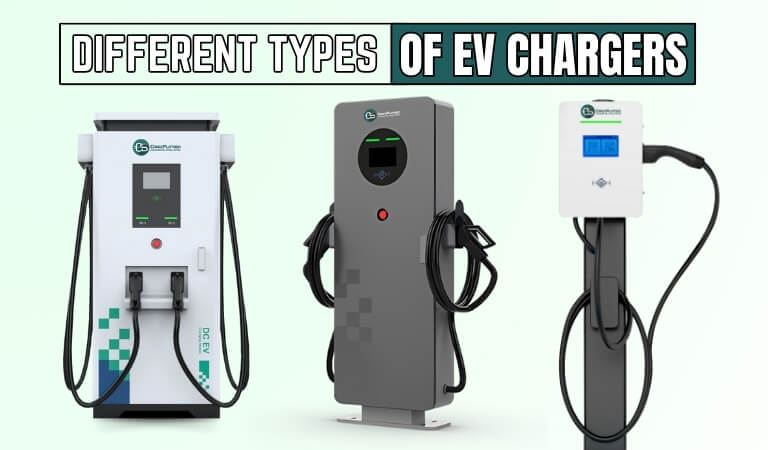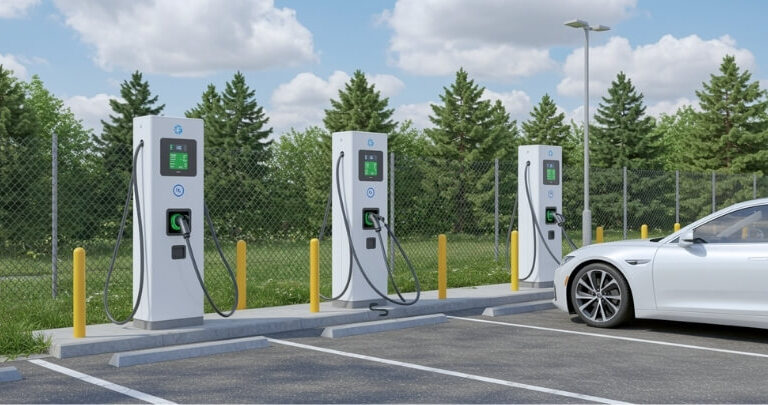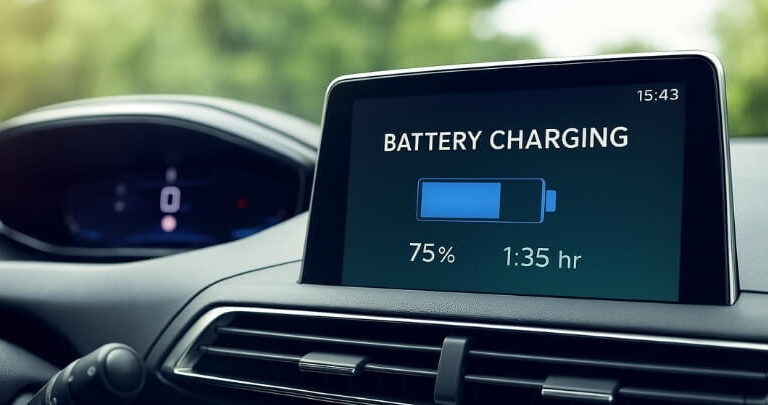Electric vehicle chargers are becoming more common as more people switch to EVs. These chargers come in different types, each offering unique speed and setup options. If you’re new to electric vehicles, you might be thinking about what works best for your car and home. That’s when the thought may cross your mind: What are the different types of EV chargers?
The three main types of EV chargers are Level 1, Level 2, and Level 3. Level 1 uses standard outlets and charges slowly. Level 2 offers faster home and public charging. Level 3 provides ultra-fast charging for highways and commercial hubs.
Curious about which charger suits your needs best or how they affect your daily driving? If you want to know more details about charging power, connector types, and usage tips, keep reading. This article covers everything you need to understand about EV chargers and how to choose the right one for your lifestyle.
What Are the Different Types of EV Chargers?
Electric vehicles are growing more popular every day, and that means more people are learning how to charge them. But not all EV chargers work the same way. Some charge your car slowly overnight, while others power it up in under an hour. Before you plug in, it helps to know the different types of EV chargers and how each one fits your needs.

Level 1 Charging – Basic and Widely Available
The most basic type of electric vehicle charging is Level 1. It uses a regular 120V AC wall outlet, the same kind you’d find in most homes. This type of charging doesn’t require special equipment, making it very accessible for everyday use. The connector type used is usually the SAE J1772, which is standard for most EVs in North America. Because it uses such low power, it’s best suited for overnight charging or when time isn’t an issue.
The power output for Level 1 charging ranges between 1.2 to 1.9 kilowatts. It typically adds about 3 to 7 miles (or 4 to 11 kilometers) of range per hour. While that may sound slow, it works well for people who drive short distances daily. A full charge from empty can take anywhere from 22 to 40 hours, depending on the vehicle’s battery size. It’s a reliable backup option if faster chargers aren’t available nearby.
Level 2 Charging – Faster and Common for Homes and Businesses
In comparison to Level 1, Level 2 charging is significantly faster and more efficient. It operates on a 208–240V power source in North America and either 230V single-phase or 400V three-phase in Europe. This means it can deliver more energy in less time, which is ideal for both home installations and commercial spaces. The connectors used vary by region—SAE J1772 is common in North America, while Mennekes (Type 2) is standard in Europe. These chargers are widely installed in parking lots, hotels, workplaces, and residential garages.
In recent years, many charging points have popped up across South Asia, especially in urban areas. For instance, if you’re looking for a reliable electric vehicle charging station in Bangladesh, you’ll find that Level 2 options are becoming more available in cities. These stations offer power outputs between 3.3 and 22 kilowatts. You can typically gain 10 to 75 miles (16 to 120 kilometers) of range per hour with these chargers. It’s the go-to choice for regular EV users who need a faster, yet affordable, way to charge.
Level 3 Charging – Ultra-Fast Charging for Highways and Fleets
DC fast charging, also known as Level 3 charging, is the fastest method of recharging an electric vehicle. It uses high-voltage DC power, typically from a 480V source in North America or 400V in Europe. This level bypasses the vehicle’s onboard charger to deliver electricity directly to the battery, making it much faster. Common connectors for Level 3 include CCS (Combined Charging System), CHAdeMO, and Tesla’s proprietary NACS. These chargers are mostly found at highway rest stops, commercial fleet locations, and dedicated charging hubs.
The power output of Level 3 chargers usually ranges from 30 to 360 kilowatts, with some newer systems capable of going even higher. With such speed, they can add 120 to over 1,400 miles (193 to 2,250 kilometers) of range per hour. For most electric vehicles, it takes just 15 to 60 minutes to reach 80% charge, depending on battery capacity and the car’s acceptance rate. These chargers are ideal when you’re in a hurry or on a long trip and need to get back on the road quickly. However, their installation and equipment costs are high, so they are less common for home use.
EV Charging Connector Types
Different regions and manufacturers use various connector types:
- SAE J1772 (Type 1): Standard for Level 1 and Level 2 charging in North America
- Mennekes (Type 2): Standard for Level 2 charging in Europe
- CCS (Combined Charging System): Supports both AC and DC fast charging; widely adopted globally
- CHAdeMO: DC fast charging standard, primarily used by Japanese manufacturers
- Tesla NACS: Tesla’s proprietary connector in North America; increasingly adopted by other manufacturers
Summary Comparison:
| Level | Power Output | Charging Speed (Range per Hour) | Typical Use Case |
| 1 | 1.2–1.9 kW | 3–7 miles (4–11 km) | Home overnight charging |
| 2 | 3.3–22 kW | 10–75 miles (16–120 km) | Homes, workplaces, public |
| 3 | 30–360+ kW | 120–1,400+ miles (193–2,250+ km) | Highways, fleets, rapid needs |
For EV owners in South Asian countries like Bangladesh, where the EV infrastructure is still developing, Level 2 chargers are becoming more prevalent in urban areas. Level 3 chargers are typically found along major highways and in commercial hubs. When selecting a charger, consider your driving habits, vehicle compatibility, and the availability of charging infrastructure in your area.
Top Benefits of Each EV Charger Type
When picking the right EV charger, it helps to know what each type offers. Level 1, Level 2, and Level 3 chargers all work differently and are useful in different situations. Some are better for daily use, while others are perfect for long trips. The table below shows the top benefits of each charger type in a clear and simple way.
| Benefit | Level 1 Charger | Level 2 Charger | Level 3 Charger (DC Fast Charging) |
| Cost to Install | Very low; uses standard home outlet | Moderate; needs a dedicated circuit | High needs commercial-grade power setup |
| Ease of Use | Plug into any wall outlet | Simple to use with home/work chargers | Plug-and-charge at public stations |
| Charging Speed | Slow; 3–5 miles per hour | Medium; 10–30 miles per hour | Very fast; 60–100+ miles in 20 minutes |
| Best Use Case | Overnight home charging | Daily use at home, office, or public spots | Long trips or quick top-ups on the go |
| Installation Requirements | None or minimal | Requires 240V outlet and some setup | Requires professional setup and maintenance |
| Vehicle Compatibility | Works with all EVs | Works with all EVs | Some plug standards vary by car manufacturer |
| Electricity Demand | Very low | Moderate | Very high – may strain the local grid if overused |
Each charger type has its own strengths, depending on what you need most. Level 1 is great for home use with no setup. Level 2 gives faster daily charging for busy users. Level 3 works best when you need quick power while on the road. Choose what fits your lifestyle and charging needs best.
What Details Matter Most When Choosing An EV Charger?
Electric vehicle chargers may look the same, but they work differently. Some charge faster, some are better for home use, and some need special setups. If you pick the wrong one, charging can become a daily hassle. Keep reading to understand the simple things that actually make a big difference.

Charging Speed And Time
Some EV chargers fill up your battery quickly, while others take hours. It depends on how much power the charger gives and what your car accepts. If you’re parking overnight, slow charging may be fine. But for daily drives or quick errands, faster options work better. Always match the charger’s power to your car’s charging needs. That way, you save time and avoid getting stuck waiting for hours.
Plug Type Compatibility
EVs don’t always use the same type of plug to charge up. Before buying a charger, you should know which plug fits your car. Most use the common J1772, but not all do. If you skip this step, the charger won’t work at all. Take a moment to check what your car supports and pick accordingly. That small check will save you from future problems and wasted money.
Home Setup Needs
Many EV chargers need special wiring or setup before they can be used. A basic charger can work from a regular wall outlet at home. But stronger ones often need a professional to install new wiring safely. Think about how much space and power your home can support. If you live in an apartment or an older house, the setup might be harder. A simple check now can save trouble and money later.
Power Limits
Each charger has its own power level, and your home’s wiring needs to match that safely. If your charger pulls more power than your system can handle, it might trip breakers or create risks. That’s why people often start by understanding EV charging power before buying. Once you get a basic idea of how power levels work, choosing the right one becomes much easier without guessing or running into problems.
Choosing an EV charger gets easier when you understand the simple parts. You don’t need to spend more for features you’ll never really use. Focus on what fits your car, your home, and your daily habits. That way, charging your EV becomes smooth and stress-free every time.
How Does Charging Speed Affect Long-Term EV Performance?
Electric vehicles use advanced battery systems, but how fast you charge them matters. People often ignore this part until problems start to show up. Even though fast charging feels convenient, it has some effects. Keep reading to learn how charging speed affects your car.

Heat from Fast Charging
When chargers push high power into a battery quickly, they create extra heat. Too much heat again and again can slowly wear down the battery cells. Over time, this reduces how far the car can drive on one charge. Charging too fast every day isn’t the best habit for battery life. While occasional fast charges are fine, regular use can make the battery age quicker than usual.
Impact on Battery Lifespan
Every battery has a set number of charge cycles before it starts to lose strength. Fast charging uses up those cycles faster than slow charging does. This can lead to shorter battery life and lower driving range. Even though it saves time, too much speed can actually cost you more later. Slower charging helps the battery stay healthy and last longer without many problems.
Internal Stress and Wear
When electricity moves too fast inside the battery, it can cause stress on internal parts. These changes don’t show up right away but build up over time. It can also affect how smoothly your car runs after a few years. Many EV brands now include systems like EV battery health monitoring to help keep track of these hidden issues quietly. It’s good to keep an eye on such things from time to time.
Battery Cooling Systems
Modern EVs come with cooling systems to manage temperature during charging. These systems try to stop the battery from getting too hot too fast. But if you charge quickly all the time, the cooling system has to work harder. That can wear it down as well. Using slower charging methods often gives both the battery and its cooling parts a break.
Mix Charging Habits
Using a mix of charging speeds can help your battery stay in better shape. You don’t need to avoid fast charging completely—just don’t rely on it every single time. Charging at home slowly overnight is a simple and safe option. It also costs less in many places. Mixing things up can keep your battery from getting weak too soon.
Fast charging is great when you’re in a rush, but it’s not the best habit daily. Slowing down sometimes can make your battery last longer and perform better. Small changes can make a big difference in the long run. Keep your car’s battery in check for better future drives.
Commonly Asked Questions
Before choosing a charger, many people have small questions that can make a big difference. These questions help clear up common confusion and help you charge your car the right way. Below are some important FAQs that go beyond what’s already explained. Take a quick look—they might answer something you didn’t even know you were curious about.
What Makes a Charger Smart or Regular?
A smart charger can connect to Wi-Fi or a mobile app. It lets you control when to start or stop charging. Some even show how much electricity you’ve used. A regular charger just starts charging when you plug it in and doesn’t have these extra features.
Can I Use the Same Charger for All Electric Cars?
Most electric cars can use the same charger, but the plug must fit. Cars from different brands sometimes have their own plug types. Some need an adapter to connect properly. Always check your car’s charging port before using a new charger.
Is It Safe to Leave the Charger Plugged in Overnight?
Yes, it is safe to leave your EV plugged in all night. Most EVs stop charging when the battery is full. This helps avoid wasting electricity or damaging the battery. Just make sure your outlet and charger are in good condition.
Do Weather Conditions Affect Charging Speed?
Yes, hot or cold weather can change how fast your EV charges. Batteries don’t like extreme temperatures and may slow down charging. In cold weather, the battery may need to warm up first. This is normal and won’t harm your car.
Can I Install a Charger Without an Electrician?
You can use a Level 1 charger without any help since it plugs into a wall outlet. But Level 2 or higher chargers need special wiring. It’s safer to call an electrician to install those properly. This keeps your home and car safe from electrical problems.
Does Charging Speed Depend Only on the Charger?
No, your car also controls how fast it can charge. Even if a charger gives high power, your car may only accept a certain amount. This limit depends on the car’s battery system. Both the charger and the car need to support fast charging together.
Are Public Chargers Always Faster Than Home Ones?
Not all public chargers are fast. Some are the same as home chargers and charge at the same speed. Only DC fast chargers are much quicker, and not every station has them. Always check the type before using a public charger.
How Can I Check if a Charger Will Work With My Car?
Check your car manual to find the plug type it uses. Then match that with the charger’s plug type and power level. You can also ask the car company or the charger seller. A quick check saves time and avoids buying the wrong one.
Do EV Chargers Use Power When Not Charging?
Yes, some chargers use a small amount of power even when not charging. This is usually very little and doesn’t cost much. Smart chargers may use a bit more to stay connected online. You can unplug it when not in use to save more.
Can I Move My Home EV Charger to Another House?
Yes, if it’s a plug-in type, you can take it with you easily. If it’s hardwired, an electrician should remove it safely. You may also need new wiring in the new house. Always plan before moving to avoid extra costs later.
Last Word
Knowing the types of EV chargers helps make smart choices while owning an electric car. Whether it’s Level 1, 2, or 3, each one has a unique purpose. You now understand the answer to what are the different types of EV chargers?
For a better charging experience, match the charger with your daily driving needs. Don’t forget to check plug compatibility, setup needs, and power capacity. Stay safe, charge smart, and enjoy your ride wherever you go!
